
After my first day in Rome, I collapsed onto my bed in my little hotel room, watched Italian TV, and got a good night’s sleep. Which was just as well, as I still had a lot to see on my last day …

First stop: the Column of Marcus Aurelius, erected in the late 2nd century to honour his victory in the Marcomannic Wars, in which the Romans defeated a series of invading German tribes. (The column at the head of the post is Trajan’s Column, the inspiration for this one.)
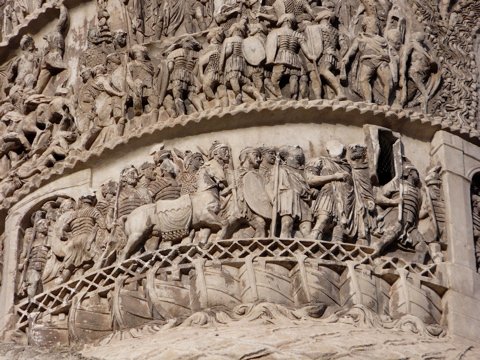
Winding up around the column is a pictorial account of the campaign. Here, the Roman Army crosses the Danube into barbarian territory, over a pontoon bridge, probably in 172. Note the window on the right — there’s a spiral staircase inside the column leading up to the platform at the top.
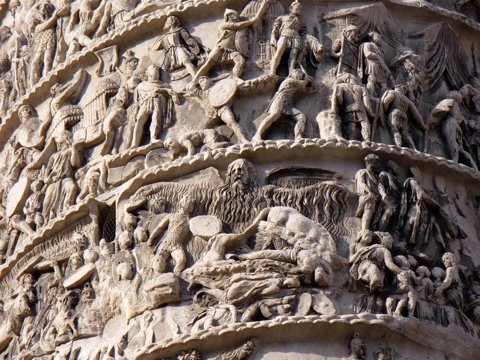
I kept my eye out for this bit, as I remembered it particularly from Anthony Birley’s biography of Marcus Aurelius. It’s the Rain Miracle, a mysterious episode which occurred in 172 or so. The legion XII Fulminata was surrounded by the Quadi and without water. Weak from thirst, they were nearly at the point of surrender when an Egyptian priest in the Emperor’s retinue used magic to bring down the rain. Reinvigorated, the legionaries defeated the Quadi. And the makers of the column commemorated this deliverance with the rather spooky figure above.

Trajan’s Column and Trajan’s Forum (above) are just behind the typewriter, and were my introduction to the whole forum complex — the heart of ancient Rome. It doesn’t look like much now, but this was once the biggest and busiest forum of them all. Also the last to be built, opening for business in 112.

This is Trajan’s Market (on the right in the previous photo, behind the fragment of wall). Ignore the black egg thing — that’s part of some modern art installation. This is way cool — it’s basically a Roman shopping centre/office building, which you can walk around in! It’s also where the corn dole (the bread in ‘bread and circuses’) was administered.
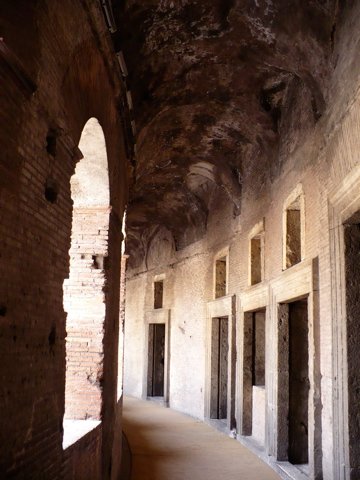
Here are some of the little shops on the second floor. I’m not sure what exactly was sold in this area, but probably something along the lines of food, oil or wine.
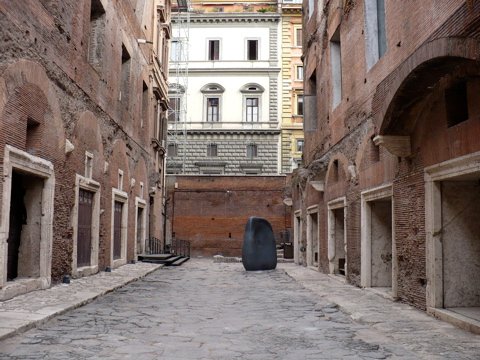
Until I make it to Pompeii or Ostia, this is the closest I’ll get to an actual ancient Roman street! And how cool would it be to live in the house behind, and peer out your window into the past?
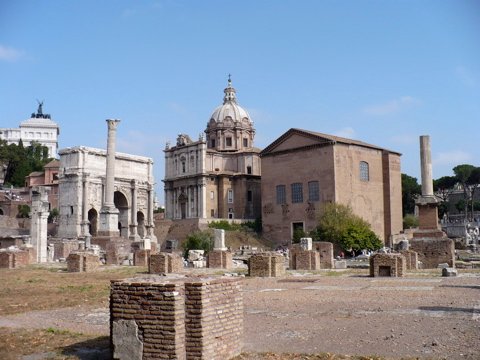
Now, this is (part of) the Roman Forum proper. It was already ancient when Augustus became emperor: Tarquinius Priscus, one of the Etruscan kings of Rome, cleared a space for it by draining the original marsh sometime around 600 BC.

The Arch of Septimius Severus. Like the columns of his imperial predecessors, it was built to celebrate a victory, this time over the Parthians. Originally, it would have had a flight of steps leading up to the arch, like Trajan’s Arch in Ancona, rather than a having a road through it as it does now, and as more modern triumphal arches tend to do.
In the foreground on the left is the Column of Phocas, erected in 608 to honour the Byzantine emperor Phocas — or rather, re-erected and re-purposed from its original function, which was to support a statue of Diocletian. Not exactly in the same class as the older columns shown above: such was the decline of Rome. It was apparently the last addition to the forum.
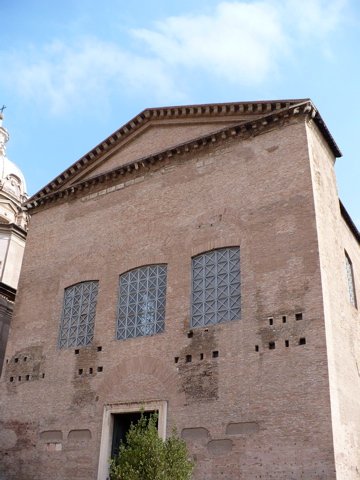
In its way, the survival of this building is as remarkable as that of the Pantheon, and it has survived for the same reason: because it was turned into a church. The Curia Julia was where the Senate of Rome met to debate and vote. Sadly, it’s not the same building that Cicero, Fabius Cunctator, Cincinnatus, etc used, or even in the same location. This site was chosen for a new senate house by Julius Caesar (hence the name), which was completed by Augustus in 29 BC. But that building itself burned down in 283, and was rebuilt under Diocletian (according to Wikipedia, but wouldn’t Maximian have been responsible, as the tetrarch in charge of Italy?)
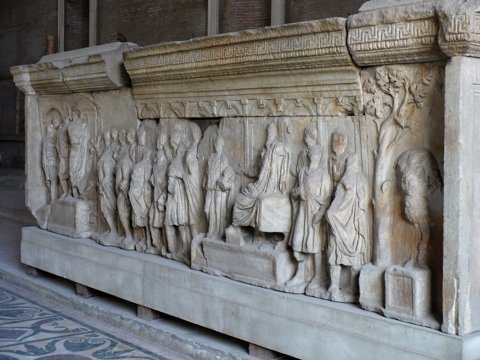
Inside the Curia. I’m not sure what this is — supposedly the Curia was mostly bare inside. I suppose that could be the emperor seated on the chair in the middle, with his senators around him? You can also get a glimpse of the colourful pavement, which dates to the early 4th century.

Just nearby is the Temple of Antoninus and Faustina, another building preserved by its use as a church (though only partly, this time). Antoninus Pius was one of the five proverbially good emperors (others included Trajan and Marcus Aurelius). I don’t know how good he really was, but he certainly loved his wife Faustina, for after her death her deified her and dedicated this temple to her. After his own death, Hadrian (another good emperor) deified Antoninus himself and re-dedicated the temple to both of them.
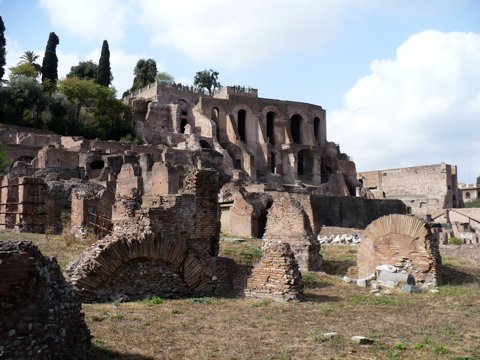
Facing in the opposite direction for a moment, in the foreground is (I think) the House of the Vestals and behind that, the Palatine Hill. Actually, you can’t see much of the hill itself because in front of it are these massive retaining walls. The Palatine was the most exclusive address in Republican Rome, and so naturally when the Emperors came along it’s where they built their palaces.

The massive Basilica of Maxentius and Constantine (M started it but C won the right to finish it at the Milvian Bridge). Nowadays a basilica is a church, but back then it was something more like a town hall. More recently, it was the setting for the wrestling at the 1960 Olympics!

Further down the Via Sacra is the Arch of Titus, built by Domitian to honour his predecessor and older brother, who died in 81. It has been restored in recent centuries (note the obviously newer bits on the sides). In the middle ages it had been used as a fortress by one Italian noble family!
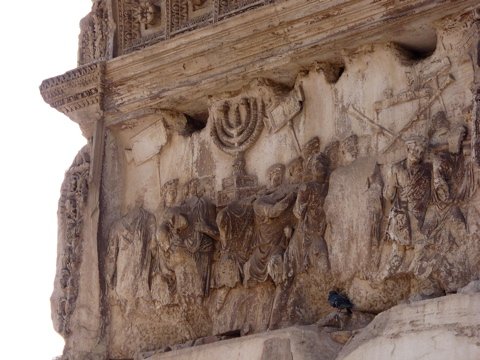
It was also used, in the 16th century, as the site for the Jews of Rome’s ghetto to declare their obedience to the Pope, Rome’s ruler. The reason for this, I presume, is because the Arch marks the defeat of the Jewish rebellion by Titus. This detail from the arch shows the looting of the Temple of Jerusalem.
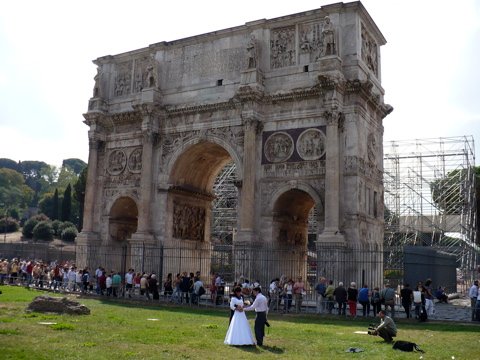
Yet another arch, possibly the most famous of all the Roman arches — the Arch of Constantine, dedicated in 315. It was probably originally the Arch of Hadrian, but as he died nearly two centuries earlier, I don’t suppose he minded being usurped too much. It’s a beautiful spot for wedding photos (possibly after holding the ceremony itself in the Pantheon), but judging from where the photographer is standing, the actual backdrop is …
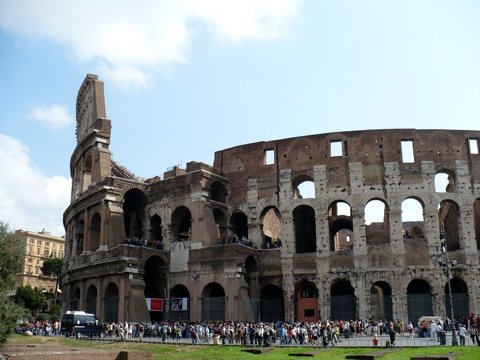
… the Colosseum! One of the most famous structures in the world. On which I promptly turned my back, and headed up the Palatine Hill. I can’t even remember why. I think it was because the same ticket covered both the Colosseum and the Palatine, but the queues were far shorter at the Palatine!

The Colosseum from the Palatine.

There are all sorts of interesting bits and pieces on the Palatine, though no structures as impressive as in the forum. This is on the side of a long pedestrian tunnel or cryptoporticus, built for Nero. (Caligula was stabbed in the Palatine cryptoporticus — oooooh, that must hurt, as Kenneth Williams might have said — though it might have been a different one which was uncovered recently.) It’s a wonder some duke or pope didn’t cart it away centuries ago.

The same goes for this, which is on a wall above a small outdoor shrine or something of that sort — there are two niches where statues presumably used to stand. Who, or what, is she?

Part of a monumental foot. Look on my works, ye mighty, etc.

There’s a small museum on the Palatine, mostly filled with assorted statuary found nearby, but some frescos too. This one of Apollo Citaredo — Apollo the cithara player?

A courtyard in Domitian’s late-1st century palace, dominated by a fountain (?).

One end of the so-called Hippodrome of Domitian. It’s too small to be for racing horses, so maybe it was a stadium for athletics, or perhaps just a garden shaped like a stadium … The oval feature shown here may be part of the restoration carried out during the reign of the Ostrogothic king Theodoric, some decades after the end of the Roman Empire in the West.

The Colosseum’s big, yeah, but it’s not the G, is it? And in fact, the name probably comes from a giant statue of Nero which stood nearby: the Romans called this the Colossus and the Colosseum the Amphitheatrum Flavium, the Flavian Ampitheatre. It wasn’t until about 900 years after it was built that people started calling it by the now-familiar name.

Closer to the level of the arena floor itself, which was made of wood and so is long gone (though much of the more durable bits have also since been plundered for building materials). But you can still see the hypogeum, the tunnels in which the animals and gladiators were kept before combat.
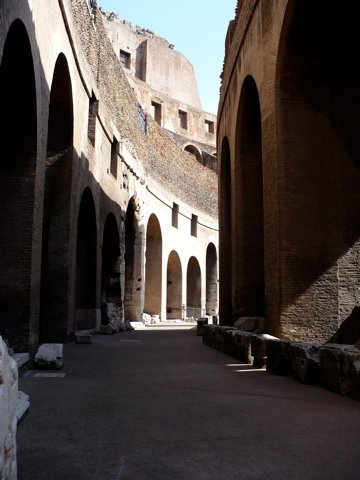
I had previously read somewhere that the Colosseum was well-designed in terms of moving people around. Recent simulations have cast some doubt on this view, however, identifying some potential bottlenecks. Perhaps that’s not so surprising — how much experience could the Romans have had with designing buildings capable of holding 50,000 people at a time?

It was by now mid-afternoon. Time to push on … but I had to take another picture of the Arch of Constantine, before walking back through the forum up to the Capitoline Hill.
![]() This work is licensed under a Creative Commons Attribution-NonCommercial-NoDerivatives 4.0 International License.
Permissions beyond the scope of this license may be available at http://airminded.org/copyright/.
This work is licensed under a Creative Commons Attribution-NonCommercial-NoDerivatives 4.0 International License.
Permissions beyond the scope of this license may be available at http://airminded.org/copyright/.


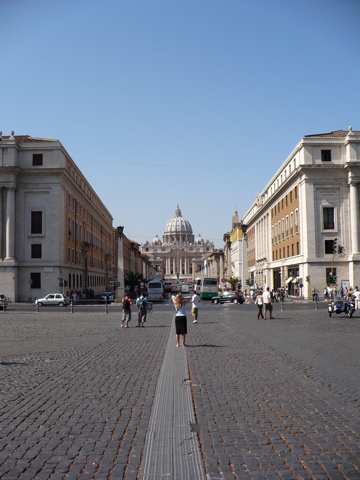
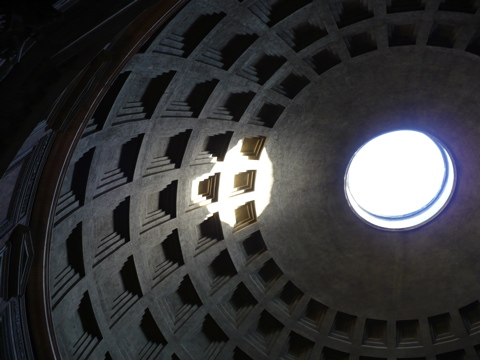
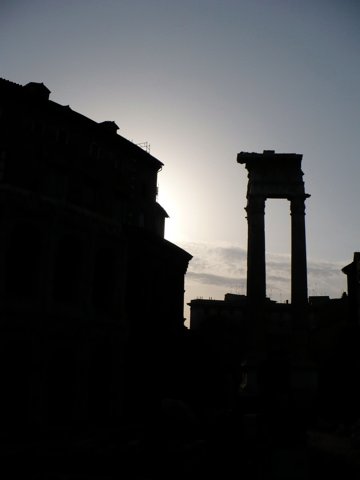
Glad you enjoyed Rome Brett. I went there with my father in 1995 for an amazing visit. We stayed just up the Via Republica in a hotel troublingly aboe the ‘Fortza Italia’ offices….
What struck me about the Forum was how casually it was ‘worn’ by the modern city, with lots of weeds and cats and remarkably little in the way of showy information or guided tours etc. Quite refreshing from the ‘heritagised’ UK. I found the Colusseum really disquieting – I’ve been to a fair few battlefields etc. but found confronting the site of the games emotionally troubling in a unique way. Must be getting soft in my old age, or two thousand years of Christian propaganda is getting to me…
Yes, I kind of liked the lack of signs and so on plastered all over the place, getting in the way of contemplation. Just bits of ruin lying around, to wander amongst. On the other hand, I did wish I’d bought a decent guidebook! Instead of relying on what I could remember of Roman history and the skimpy Lonely Planet Best of I did buy.
To be honest, I didn’t find the Colosseum or the Roman Forum itself to be quite as powerful as I’d expected — perhaps precisely because I did expect it? The bits which interested me most were probably the ones I hadn’t heard of before, such as Trajan’s Market. And the Capitoline Museums, but that’s pre-empting the next post …
Please cut my suspense! Did you go to the Italian Air Museum or not (Vigna di Valle)? A must for any Schneider Trophy enthusiast…
No, I didn’t even know it existed! Maybe next time …
best page on it: http://www.targeta.pwp.blueyonder.co.uk/vigna_di_valle.htm
next time don’t miss it ;)
Me too – like Simon I was in Rome in 95. Had no idea at all of the Air Museum. The Macchi Castoldi MC.72! Wow! They don’t make ’em like that anymore.
And I really enjoyed the very points made above about Rome, the way you can walk around a corner and encounter some extraordinary ancient thing. I hope to return in 2010.
I have to smile remembering the difficulty we had with the Italian rolled R. Try ordering a Merlot. And my better half’s hilarious encounter in a Trattoria trying to avoid meat (being a vegetarian). We thought carne was pronounced “car-nay” but it isn’t. That’s cane. The whole place was in fits wondering why we were trying to avoid eating dog! Carne is “carrrrh-nay”.
At least you tried! I got by on si, no, grazie, per favore and maybe uno … pretty lame.
Vigna di Valle does look like a great museum, especially all the seaplanes and flying boats. The WWI Caproni bombers would be cool too.
Brett, I’m afraid I’m going to get a bit schoolmasterly on you …
Arch of Septimius Severus: The side passages were approached by steps. The central passage always had a road passing through it; it’s the Via Sacra that was used for Roman triumphs.
Column of Phocas: It often gets overlooked that Rome was part of the Byzantine (or as they thought of it ‘Roman’) empire at the time of Phocas, so it’s not quite like a foreign ruler making a donation.
Curia Julia: The Curia’s not quite on the same place as the Republican Senate House, but it’s probably adjacent to it. The building was destroyed in a fire of AD 283, and rebuilt by Diocletian after coming to power in AD 284. Maximian did not become emperor until AD 283.
The relief is the so-called Plutei of Trajan (though it may date to Hadrian’s reign). It was mounted in the Forum, opposite the Curia.though that wasn’t the original position.
Temple of Antoninus and Faustina: Antoninus Pius succeeded Hadrian, and deified him, not the other way round. The rededication of the temple of Faustina happened under Marcus Aurelius.
The next photo shows the Horrea Vespasiani, built as a fish-market. The House of the Vestals is off to the right (it can just be seen in the photo, in front of the retaining walls of the Domus Tiberiana).
Arch of Constantine: Suggestions that the Arch began life as a monument of Hadrian or Domitian are generally not accepted now. However, the Arch does using material almost all reused from other monuments, and most of the architectural (as opposed to decorative) elements come from another unidentified triumphal arch. The decorative programme mostly (though not entirely) comes from imperial monuments of Trajan, Hadrian and Marcus Aurelius. The Hadrianic panels (some of the roundels) may have come from a monument to Hadrian’s lover Antinoos.
The female figure from the Palatine is clearly a sphinx, but I don’t know anything more about her. (She looks post-Renaissance rather than Roman to me, but I couldn’t swear to that.)
Apollo Citaredo is Apollo the cithara player, if that was a problem.
And that is a fountain in the next photo.
The ‘Hippodrome’ is generally (and rightly, I’d say) accepted to be a sunken garden.
Thanks, Tony, I was wondering when you were going to point out some of the myriad errors in these posts :) Oops on Hadrian/Antoninus, particularly … I DID know that, I swear …
With Phocas, I wasn’t implying that he was a foreign ruler, but rather that one little column (and that nicked from somebody else’s memorial) is pretty sad compared with the various columns and arches dedicated to earlier rulers.
I wondered that about the sphinx lady too — for one thing, it’s not very weathered for something carved so finely and (presumably) exposed to the elements for a lot of centuries. Maybe whoever put there thought it’s something like the Romans might have done?
Pingback: Airminded · Rome 2b
Thank you for a fascinating page tour.
You had me scurrying all over the ‘net’ for hours looking and wondering, for example, some of the structures have a lot of holes in them, for example, the courtyard in Domitian’s late-1st century palace; are these for construction as in Petra or are they for roofing.
Its hard to comprehend how such huge high structures could be safely and adequately roofed?
Glad you enjoyed it — I agree, those huge buildings are pretty amazing (and the Pantheon most of all). I’m no Roman historian (not that this needs to be pointed out!) but I think the strength and lightness of Roman concrete had a lot to do with it, and they were pretty confident with arches too. The Byzantines continued this tradition, one day I would love to see the Hagia Sophia…